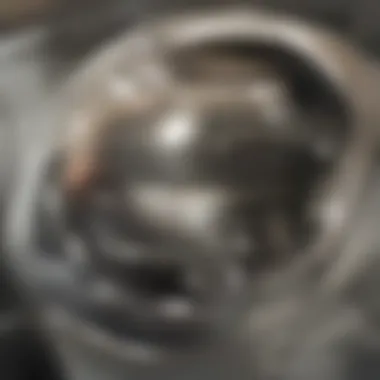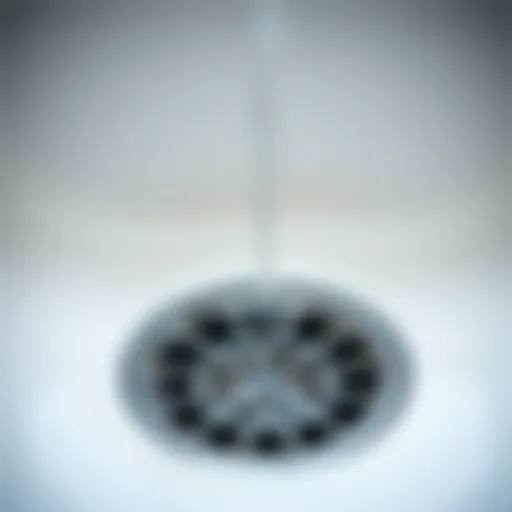Understanding Slow Flushing Toilets: Causes & Solutions


Intro
Toilets are a vital part of any home, yet many homeowners overlook their functionality until a problem arises. Slow flushing toilets, while not necessarily clogged, can present frustration and confusion. Understanding the reasons behind this issue can help homeowners manage and maintain their plumbing systems effectively. This article will delve into the mechanics of toilet flushing, common causes of slow performance, and how to address these concerns.
A slow flush occurs when the toilet takes longer to empty and refill than expected. This inefficiency can stem from various internal and external factors. By learning these details, homeowners can take proactive steps to ensure their toilets operate correctly.
The Mechanics of Toilet Function
Understanding how toilets work is crucial to identifying slow flushing issues. A toilet's operation relies on a combination of gravity and water pressure. When you flush the toilet, the handle lifts a flapper valve, allowing water to rush from the tank into the bowl. Gravity then helps to push waste through the trap and into the drain. Once the tank is emptied, the flapper closes, and a refill valve restores water to the tank and bowl.
Normally, a well-functioning toilet performs this cycle efficiently. However, slow flushing may signify underlying issues affecting this mechanism.
Causes of Slow Flushing Toilets
There are several reasons why a toilet may flush slowly, even when not clogged:
- Low Water Level in Tank: Water levels too low can hinder flushing efficiency. Proper adjustment may be needed.
- Weak Flush Mechanism: Parts like the flapper or flush valve may be worn out or damaged, leading to ineffective flushing.
- Mineral Buildup: Over time, minerals from water can accumulate in the siphon jet or trap, obstructing flow.
- Poor Flushing Design: Some toilets are designed with less powerful flushing systems, leading to lower performance.
A toilet's function can be complicated, but understanding these basic causes can help address the main issue.
Maintenance Tips for Optimal Performance
Proper maintenance is vital for ensuring a toilet continues to operate effectively. Consider these tips:
- Regular Cleaning: Clean the toilet regularly to prevent mineral buildup. Use non-abrasive cleaners to protect surfaces.
- Inspect Components: Periodically check the flapper and flush valve for wear and replace when necessary.
- Adjust Water Levels: Ensure the float is set to the appropriate height for optimal flushing.
- Routine Flush Tests: Perform flush tests to check for proper operation, making adjustments as needed.
Maintaining a toilet with these simple practices can greatly improve performance and prevent slow flushing.
When to Seek Professional Assistance
While many flushing issues can be solved independently, some complications may require a professional plumber. Consider seeking help if:
- Persistent Slow Flushing: Continual issues despite troubleshooting attempts.
- Visible Damage: Signs of leaks or damage in the plumbing system that need expert insight.
- Unfamiliar with Repairs: If a homeowner is uncomfortable performing repairs, it is safer to consult a professional.
Understanding slow flushing toilets not only aids homeowners in troubleshooting but also promotes a proactive approach to plumbing maintenance. Regular management can facilitate a smoother experience in homeownership and potentially lead to long-term savings.
Foreword to Slow Flushing Toilets
Slow flushing toilets can be a unique nuisance for homeowners. They do not always indicate a clog, yet the problem can lead to frustration. Understanding the mechanics behind slow flushing is essential for maintaining a functional bathroom. This section will explore what defines a slow flushing toilet and why proper flushing is crucial.
Defining Slow Flushing Toilets
A slow flushing toilet does not clear waste effectively within the expected time. The flush may not generate enough force or volume to empty the bowl. Various factors can contribute to this issue. The toilet may be functioning poorly without being completely clogged. Homeowners might notice a weak flush, requiring multiple attempts to effectively clear waste. Recognizing this can help in troubleshooting the issue more efficiently.
Key characteristics of slow flushing toilets include:
- Inconsistent water levels in the tank
- Weak flow during the flush
- Extended time required for proper waste disposal
These toilets can disrupt daily routines and create hygiene concerns if the problem persists. Therefore, it is important to take note of the signs and seek to identify the root of the problem.
The Importance of Proper Flushing
Understanding the importance of proper flushing goes beyond mere convenience. It affects the overall hygiene and functionality of bathrooms. Proper flushing helps maintain lower water usage, which can lead to cost savings on water bills. Insufficient flush power can lead to waste accumulation, creating a breeding ground for bacteria.
When toilets do not function as designed, it can eventually impact the plumbing system. Over time, residual waste can accumulate in drain lines, exacerbating problems and leading to more significant plumbing issues. Homeowners should prioritize maintenance practices to ensure toilets flush efficiently.
"A well-functioning toilet is an essential component of a healthy and pleasant home environment."
By focusing on understanding these slow flushing toilets, homeowners can take the necessary steps toward troubleshooting and fixing this issue. Knowledge leads to better maintenance, ensuring the plumbing system remains healthy and efficient.
Common Causes of Slow Flushing
Understanding the causes of slow flushing toilets is crucial for homeowners seeking effective solutions. Slow flushing can lead to frustration and an increased risk of plumbing issues if neglected. By pinpointing the specific elements contributing to slow toilet performance, one can address these concerns promptly. This section will delve into several common causes, offering insights into each and helping homeowners make informed decisions.
Insufficient Water Supply
One likely reason for a slow flushing toilet is an insufficient water supply. Toilets depend on a strong flow of water to clear waste effectively. If the supply line is restricted, perhaps due to kinks, blockages, or even low municipal water pressure, the toilet may simply not receive enough water during the flush.
To identify this issue, one should observe the water level in the toilet tank. If the tank doesn’t fill to the appropriate level, the toilet will struggle to flush properly. Homeowners can increase the water supply by ensuring that the main valve is fully open and checking for any obstructions in the supply lines.


Flushing Mechanism Malfunctions
The flushing mechanism is another potential culprit in slow flushing toilets. This system includes components like the handle, flapper, and lift chain, all of which work in sync to initiate a forceful flush. If any part of this mechanism is malfunctioning, the flush may be weaker than intended, leading to inadequate waste disposal.
Regular inspection of these components is advisable. For example, if the flapper is worn or not sealing properly, it may not allow enough water to flow into the bowl during a flush. Similarly, a broken lift chain can prevent the flapper from lifting effectively. This can be resolved by replacing worn components and ensuring that everything operates smoothly.
Incorrect Flush Valve Settings
Flush valve settings play a significant role in the efficiency of a toilet's flush. If the flush valve is set incorrectly, it may not release enough water into the bowl. This situation can result from incorrect adjustments, particularly after repairs or replacements.
To check the setting, homeowners should refer to the manufacturer’s guidelines for the specific toilet model. Adjusting the height of the float or the flush valve can often rectify this issue. If done correctly, these adjustments can significantly enhance flushing power.
Drain Line Issues
Lastly, drainage line problems can contribute to slow flushing. Even if the toilet is not visibly clogged, underlying issues within the drain line can affect performance. For instance, partial blockages caused by buildup might restrict the flow, resulting in slower flushing.
Homeowners should be alert for any sudden changes in flushing behavior or slow drainage from the toilet. Regular cleaning and using enzyme-based drain cleaners can help prevent the buildup of debris. In persistent cases, consulting a professional may be necessary to inspect more extensive issues within the plumbing system.
By understanding these common causes, homeowners can take proactive steps to address slow flushing toilets effectively.
Diagnosing the Problem
Diagnosing the problem of slow flushing toilets is a critical aspect of addressing this issue effectively. By identifying the root cause, homeowners can take appropriate measures to restore optimal functionality. A thorough diagnosis not only helps in resolving current problems but also aids in preventing future occurrences. This understanding empowers homeowners and enhances their ability to maintain their plumbing systems properly.
Visual Inspection Techniques
One of the first steps in diagnosing a slow flushing toilet is to conduct a visual inspection. This involves examining various components within the toilet. Look for any obvious signs of wear or damage, such as cracks in the tank or bowl. Inspect the flapper valve for signs of deterioration; it should create a watertight seal when closed. Also, check the lift chain attached to the flapper. Ensure it is not tangled or too loose.
Key steps for visual inspection:
- Check for visible damage on the toilet components.
- Examine the flapper and chain for proper functioning.
- Look at the flush handle to make sure it operates smoothly.
This initial assessment lays the foundation for further diagnosis.
Monitoring Water Levels
Monitoring water levels is vital in understanding how the toilet operates. Knowing the optimal water level in the tank can help identify if it is low. If the water level is too low, it can result in insufficient water being pushed into the bowl during a flush. Typically, the water level should be one inch below the top of the overflow tube.
To monitor the water level effectively, simply remove the tank lid and visually assess the water height. If necessary, adjust it using the float arm mechanism. Keeping the water level in check can significantly enhance flushing performance.
Assessing the Flush Cycle
Assessing the flush cycle is essential for diagnosing how well the toilet is functioning. Observe how long the flush takes and whether it operates smoothly. A slow or incomplete flush may indicate malfunctioning components or issues with the water supply.
During the assessment, pay attention to any irregularities, such as:
- Unusual sounds during flushing
- Insufficient water entering the bowl
- Delayed refill time
Documenting these aspects provides valuable insights that can lead to quicker resolution of issues. Effective diagnosis allows for targeted interventions, which can save time and resources in toilet maintenance.
Important Note: Regular checks and monitoring can prevent more significant plumbing issues down the line.
Water Supply Considerations
In the context of slow flushing toilets, understanding water supply considerations plays a critical role. Water supply issues can significantly affect the performance of a toilet. A toilet relies on adequate water pressure and flow to function correctly, ensuring a powerful flush. Without the right conditions, even a well-maintained toilet may flush inefficiently.
Understanding Water Pressure
Water pressure is the force that pushes water through pipes. It is measured in pounds per square inch (PSI). Toilets typically require a pressure of around 20 to 80 PSI to achieve optimal flushing power. If the pressure is too low, the toilet may not refill quickly or adequately after a flush.
To determine whether low water pressure is the issue, you can perform a simple test:
- Turn on multiple faucets in your home simultaneously.
- Check the flow rate of each fixture and note any differences.
- If you notice a significant drop in pressure, this may be an indicator of a broader plumbing issue.
Maintaining proper water pressure may involve adjusting your pressure regulator or consulting a plumber if necessary.
Identifying Supply Line Blockages
Blockages in the water supply line can also result in inadequate flushing. These blockages may occur due to scale buildup, debris, or even the settling of sediment within pipes. Regular maintenance of the supply lines is crucial for identifying potential issues.


Some signs of blockages may include:
- Unusual sounds when flushing
- A consistent drop in toilet performance
- Noticeable differences in water flow in other fixtures
To identify and clear these blockages, consider the following steps:
- Examine the valve feeding the toilet. Ensure it's fully open.
- Disconnect the supply line to inspect for visible debris or buildup.
- Use a small brush or pipe cleaner to clear out any obstructions within the line.
Regularly checking your supply lines can prevent future complications and ensure your toilet flushes efficiently.
Effective water supply management is crucial for toilet efficiency and can save homeowners from future plumbing issues.
Evaluating the Flushing Mechanism
Evaluating the flushing mechanism of a toilet is critical for diagnosing slow-flushing issues. This component comprises several parts, all working together to ensure effective waste removal. A functional flushing mechanism can prevent unwarranted stress on the plumbing system and reduce maintenance costs. Moreover, understanding how this mechanism operates offers insights into improving efficiency.
Examining the Handle and Flapper
The handle and flapper play a vital role in the flushing process. When the toilet handle is pressed, it lifts the flapper, allowing water from the tank to rush into the bowl. If the flapper is worn out or misaligned, it may not seal properly, leading to insufficient water entering the bowl during flushing. Check the handle for any looseness. If a handle is stiff or does not return to its original position, that can indicate an issue that might disrupt the flush.
To inspect the flapper:
- Turn off the water supply to the toilet.
- Remove the tank lid and observe the flapper's movement when the handle is operated.
- Ensure the flapper is not warped and sits correctly over the flush valve.
If adjustments do not resolve the issue, consider replacing the flapper. This replacement is usually a simple task and can significantly improve flushing performance.
Testing the Lift Chain
The lift chain connects the handle to the flapper. It plays an essential part in raising the flapper when you flush. If the chain is too long or too short, it may not operate properly. A loose chain might cause the flapper to remain partially open, wasting water and leading to slow flushing. Conversely, a tight chain could also prevent the flapper from lifting fully.
To test the lift chain, follow these steps:
- Check the tension by pulling it gently. There should be slight slack without excessive looseness.
- Adjust the chain's length if necessary, ensuring that it allows the flapper to rise fully when the handle is pressed.
- Test the flush. If the toilet still flushes slowly, further exploration may be needed.
By focusing on the handle and lift chain, homeowners can often resolve slow-flushing dilemmas without needing to contact a plumber. Proper evaluation and adjustments can make a considerable difference in toilet performance.
Adjusting the Flush Valve
The flush valve is an essential component in the functionality of a toilet. It governs the flow of water into the bowl during the flushing process. If your toilet is flushing slowly but is not clogged, it is likely that the flush valve needs to be adjusted. Working on the flush valve can improve the performance of your toilet and ensure that it uses the right amount of water during each flush.
Adjusting the flush valve is significant because it can lead to better flushing efficiency and help avoid the frustrations associated with poor toilet performance. Several factors such as low water levels in the tank or misalignment of the flush mechanism can contribute to slow flushes. By addressing these specifics, you can optimize your toilet’s functionality.
Steps to Adjust the Flush Valve
- Turn Off Water Supply: First, locate the shut-off valve behind the toilet. Turn it clockwise to stop water flow.
- Remove the Tank Lid: Gently lift off the lid of the toilet tank. Make sure to set it aside in a safe place.
- Inspect the Flush Valve: Identify the flush valve, usually situated in the center of the tank. Check for any visible obstructions or build-up.
- Adjust the Chain: If the chain connected to the flapper is too loose or tight, adjust it. The ideal slack should allow for smooth operation.
- Change the Water Level: If the water level in the tank is too low, locate the adjustment screw on the float mechanism. Turn it clockwise to raise the float, which in turn raises the water level.
- Reconnect: Put the tank lid back on and turn the water supply back on. Flush the toilet to test the adjustments.
When to Replace Components
Over time, components of the flush valve can wear out, which may lead to persistent issues even after adjustments. Here are a few signs that components might need replacing:
- Frequent Water Leaks: If you notice water leaking from the tank, the flapper may no longer be sealing properly.
- Corrosion or Damage: Components such as the flush valve body can corrode, affecting their function. Inspect for signs of rust or cracks.
- Inconsistent Flushing: If you still struggle with flush effectiveness after adjustments, it might signify that parts need replacement.
In certain scenarios, replacing the entire flush valve system may be necessary. Make sure to consult the manufacturer's manual or seek professional help if you feel uncertain about your skills in handling the task.
Regular adjustments and timely replacements can prolong the life of your toilet and enhance its functionality.
Addressing Drain Line Problems
A toilet may perform efficiently, yet still experience slow flushing. This often leads to the suspicion that there is a clog present. However, drain line problems can also contribute significantly to this issue. It is crucial to understand the potential drain line issues in the context of slow flushing toilets. Addressing such problems is essential for maintaining a fully functional plumbing system and to prevent further complications that could arise from neglecting minor issues.
When the drain lines are compromised, the flushing process can be affected due to insufficient drainage. This can result in water backing up, which may seem like a clog, whereas it’s more about the drainage efficiency. Properly addressing drain line problems can help in several ways:
- Restoring Effective Drainage: Enhancing the flow can improve the flushing capability of the toilet.
- Preventing Future Clogs: By addressing small issues early, one can avoid larger, time-consuming problems down the line.
- Maintaining Overall Plumbing Health: Ensuring all aspects of plumbing work harmoniously can save costs and time in the long run.
Considerations about drain line problems often include regular inspections, understanding how waste moves through the system, and recognizing signs of impending issues. Proactive measures can mitigate many common problems.
Recognizing Signs of Drain Issues
Identifying potential drain line problems can be done through observation. Some signs to look for include:


- Slow Draining Sinks or Tubs: If multiple fixtures in your home are slow to drain, it may indicate a line issue.
- Unpleasant Odors: Foul smells coming from the toilet or drains can signal decomposing waste stuck in the drain line.
- Frequent Backups: A toilet that backs up multiple times can suggest a blockage or line failure.
- Gurgling Noises: Sounds from toilets or other fixtures when flushing are often indicative of air trapped in the drain line.
- Water Pooling: Any standing water in surrounding areas can indicate a drainage problem.
Recognizing these signs early can assist in taking necessary actions to address drain line problems before they escalate.
Options for Clearing Minor Blockages
When facing minor blockages that affect drainage efficiency, there are several methods homeowners can employ before calling a professional:
- Plunger Use: A common tool, using a plunger can remove furniture and barriers that cause blockages.
- Drain Snake: A drain snake can reach deeper blockages that may not be reachable by a plunger.
- Baking Soda and Vinegar: This natural approach, when combined, can help dissolve minor build-up and clear slow drains.
- Boiling Water: Pouring boiling water down the drain may help eliminate grease or soap scum.
If the issue persists, it might be better to consult with a plumber. They can use specialized tools, like hydro-jetting, to thoroughly clean the line without damaging the plumbing.
Being attentive to drain line problems can save time and money. Regular maintenance can ensure that your toilet flushes efficiently without requiring major repairs.
Addressing drain line problems is an integral part of maintaining your toilet's function. By recognizing the signs and knowing how to handle minor issues, homeowners can sustain an effective and healthy plumbing system.
Preventative Measures
Preventative measures play a critical role in maintaining the functionality of slow flushing toilets that are not clogged. By adopting a proactive approach, homeowners can minimize the risk of inefficiencies and prolong the lifespan of their plumbing systems. Regular attention to these preventive steps can lead to improved toilet performance and lower maintenance costs over time.
Regular Maintenance Practices
In order to ensure optimal toilet performance, regular maintenance practices should be implemented. These practices include:
- Routine Inspections: Check the toilet regularly for any signs of wear or malfunction. Look for leaks around the base and inspect the flushing mechanism.
- Flushing Efficiency Tests: Conduct tests to confirm that the toilet is flushing as intended. This can be done by monitoring how well the toilet clears waste during flush cycles.
- Cleaning the Toilet Components: Periodically clean the tank, bowl, and flushing components. This eliminates buildups that can negatively affect performance. Use appropriate cleaning solutions while avoiding harsh chemicals that may damage components.
- Monitoring Water Levels: Check the water level inside the toilet tank. It should be at the recommended height for efficient flushing. Adjust as necessary to ensure proper water levels are maintained.
Implementing these regular maintenance practices can help in identifying potential issues before they escalate into major problems.
Best Practices for Toilet Care
To enhance toilet care, homeowners should consider integrating a few best practices into their routines. These include:
- Educate Household Members: Make sure everyone knows what can and cannot go down the toilet. Avoid flushing non-biodegradable items like wipes, feminine products, or excessive toilet paper.
- Adjust Flush Settings: Some toilets may have adjustable flush settings. Evaluate and modify these settings as per the water flow required for effective flushing without wastage.
- Use Efficient Toilets: If replacing a toilet, opt for high-efficiency models. These toilets conserve water while providing powerful flushes, which can prevent slow flushing issues.
- Mind the Fill Valve: Regularly inspect and clean the fill valve to ensure it operates smoothly. A malfunctioning fill valve can impair the toilet’s ability to refill properly after flushing.
Overall, making these practices part of your home maintenance routine can significantly reduce the likelihood of encountering slow flushing toilets in the future.
Professional Help and When to Call a Plumber
In some situations, the underlying issues causing a slow flushing toilet may go beyond simple maintenance. Therefore, understanding when to call a plumber is crucial for maintaining the functionality of your bathroom and home. The plumbing system involves complex connections and components that a layperson may not fully diagnose or repair. If you encounter persistent slow flushing despite trying common troubleshooting techniques, seeking professional help can save both time and aggravation.
Identifying Complex Issues
There are several signs that may indicate more complex problems within your toilet system or related plumbing. If you notice multiple toilets in your home flush sluggishly, it could point to underlying issues in the sewer line rather than just individual toilet malfunctions. Additionally, if you experience recurring blockages or slow clearing in other fixtures, this suggests a need for professional intervention.
Consider these indicators:
- Strange Noises: Unusual sounds such as gurgling when flushing may indicate air trapped in the plumbing system.
- Frequent Backups: Repeated backups in various drains could signal blockage in the main sewer line, necessitating expert evaluation.
- Slow Draining: If several drains are slow, it could mean you have an issue with drainage that requires further investigation.
If you find yourself confronting multiple indicators, it's wise to consult a plumber who can assess the entire plumbing system rather than just focusing on the toilet.
Choosing the Right Plumbing Professional
Selecting a qualified plumbing professional can make a significant difference in the outcome of your plumbing issue. Look for a plumber who has both experience and proper licensing. Here are some key considerations when choosing a professional:
- Licensing and Certification: Ensure that the plumber is licensed to work in your area. Verify any certifications they claim to possess, as this can indicate a level of competence.
- Reputation and Reviews: Check online reviews and ratings. Websites like Facebook and Reddit can provide insight into others' experiences with specific plumbers.
- Experience with Similar Issues: Inquire about the plumber's experience with slow-flushing toilets. A specialist in plumbing issues similar to yours can often provide more effective solutions.
- Warranty and Guarantees: Find out if they provide any warranties on their work. A reliable plumber will often stand behind their services, which offers some peace of mind.
- Cost Estimates and Transparency: A good plumber will provide a detailed estimate before starting any work and be honest about potential costs involved. Transparency in pricing can help avoid unexpected expenses later on.
Plumbers with a strong foundation of knowledge can identify not just immediate issues, but also potential future problems that could affect your toilet's performance.
By taking these steps, you can ensure that you are making an informed choice about who handles your plumbing needs. The right professional can not only address the slow flushing issue, but also help spot underlying system problems that may arise down the line.
Culmination
The conclusion of this article is a pivotal moment that synthesizes the key points discussed throughout the sections on slow flushing toilets. Understanding the mechanics behind these plumbing issues is crucial for any homeowner. The primary benefit of grasping this information is the ability to identify problems early and act accordingly, which can save time and expense in the long run.
Summary of Key Insights
In this article, we examined the various aspects of slow flushing toilets that are not clogged. We discussed the importance of water supply, the role of the flushing mechanism, and adjustments that homeowners can make to optimize performance. Recognizing the signs of drainage issues and understanding how to troubleshoot these problems equips homeowners with the knowledge to maintain their toilets effectively. This not only leads to a smoother flushing experience but also extends the life of the toilet itself.
"Effective maintenance is a cornerstone of proper plumbing management."
Encouragement for Proactive Maintenance
Consistent and proactive maintenance should be embedded into the regular home care routine. Simple practices, like regularly checking the toilet's water levels and the flushing components, ensure that problems are caught before they become significant. Homeowners should consider setting reminders to inspect their toilets periodically, looking out for shifts in flushing behavior. This preventive approach empowers individuals to manage their plumbing systems effectively.
Additionally, keeping an eye on any unusual noises or delays during the flush cycle can indicate underlying issues that require attention. Engaging in these practices promotes sustainability and efficiency, reflecting a responsible homeowner's commitment to maintaining their property.







